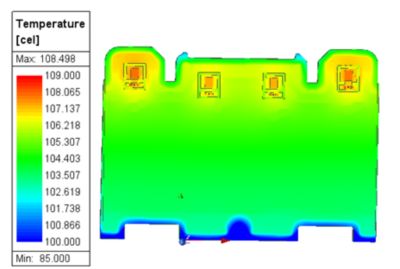Case Study
-
United States -
United Kingdom -
India -
France -
Deutschland -
Italia -
日本 -
대한민국 -
中国 -
台灣
-
Ansys is committed to setting today's students up for success, by providing free simulation engineering software to students.
-
Ansys is committed to setting today's students up for success, by providing free simulation engineering software to students.
-
Ansys is committed to setting today's students up for success, by providing free simulation engineering software to students.
-
Contact Us -
Careers -
Students and Academic -
For United States and Canada
+1 844.462.6797
“Using Ansys Icepak software for our automotive interior lighting project transformed our approach to thermal management. The accurate simulations saved us time and allowed us to optimize material choices without the need for costly prototypes. Ansys has been a vital partner in our development process.”
— Antoni Vilatimó, Laboratory Engineer, Elausa
In the automotive industry, effective thermal management of electronic components is crucial, especially in space-constrained environments like interior ambient lighting. This project involved a new type of light-emitting diode (LED) with integrated circuits (ICs), needing a thorough understanding of thermal behavior to ensure reliability.
Challenges
The primary challenge was managing the power output of the LED printed circuit board (PCB) in high ambient temperature and within a limited space surrounded by plastic materials, which restricted airflow. The team required a simulation tool that could accurately model thermal performance and integrate seamlessly with existing electronic computer-aided design (ECAD) systems. Ansys Icepak® electronics cooling simulation software was chosen for its usability, precision, speed, and excellent technical support.
Engineering Solutions
To address the thermal management challenge, the team utilized Icepak software to perform comprehensive simulations of the PCB. Key features that facilitated their success included:
- Advanced computational fluid dynamics (CFD): enabled detailed conjugate heat transfer analysis to predict airflow and temperature distribution
- ODB++ import functionality: streamlined the integration of PCB layout designs for precise simulation of heat conducted through copper traces and vias
- Material testing capabilities: enabled rapid evaluation of materials for optimal thermal performance without prototyping
- Customizable meshing approach: facilitated accurate modeling of complex geometries, which was essential for tightly packed designs, and enabled an extensive meshing optimization, which significantly reduced computation time without losing accuracy

Thermal results of a section of the LED printed circuit board (PCB) inside the car surroundings
Benefits
Icepak software provided significant advantages throughout the development process.
- Accurate and fast thermal simulations: enabled the assessment of materials with differing thermal conductivities to optimize component cooling
- Time savings: eliminated the need for physical prototypes, accelerating the design cycle and saving more than two months in time
- Seamless ECAD Integration: enabled easy import of PCB designs using ODB++ format, facilitating detailed simulation of copper planes and via configurations
- Enhanced technical support: Provided ongoing assistance, ensuring the team could leverage the full capabilities of the software and become autonomous quickly
By utilizing Icepak software, the team successfully maintained low operating temperatures to enhance the reliability and lifespan of their automotive lighting solutions.
Let’s Get Started
If you're facing engineering challenges, our team is here to assist. With a wealth of experience and a commitment to innovation, we invite you to reach out to us. Let's collaborate to turn your engineering obstacles into opportunities for growth and success. Contact us today to start the conversation.











